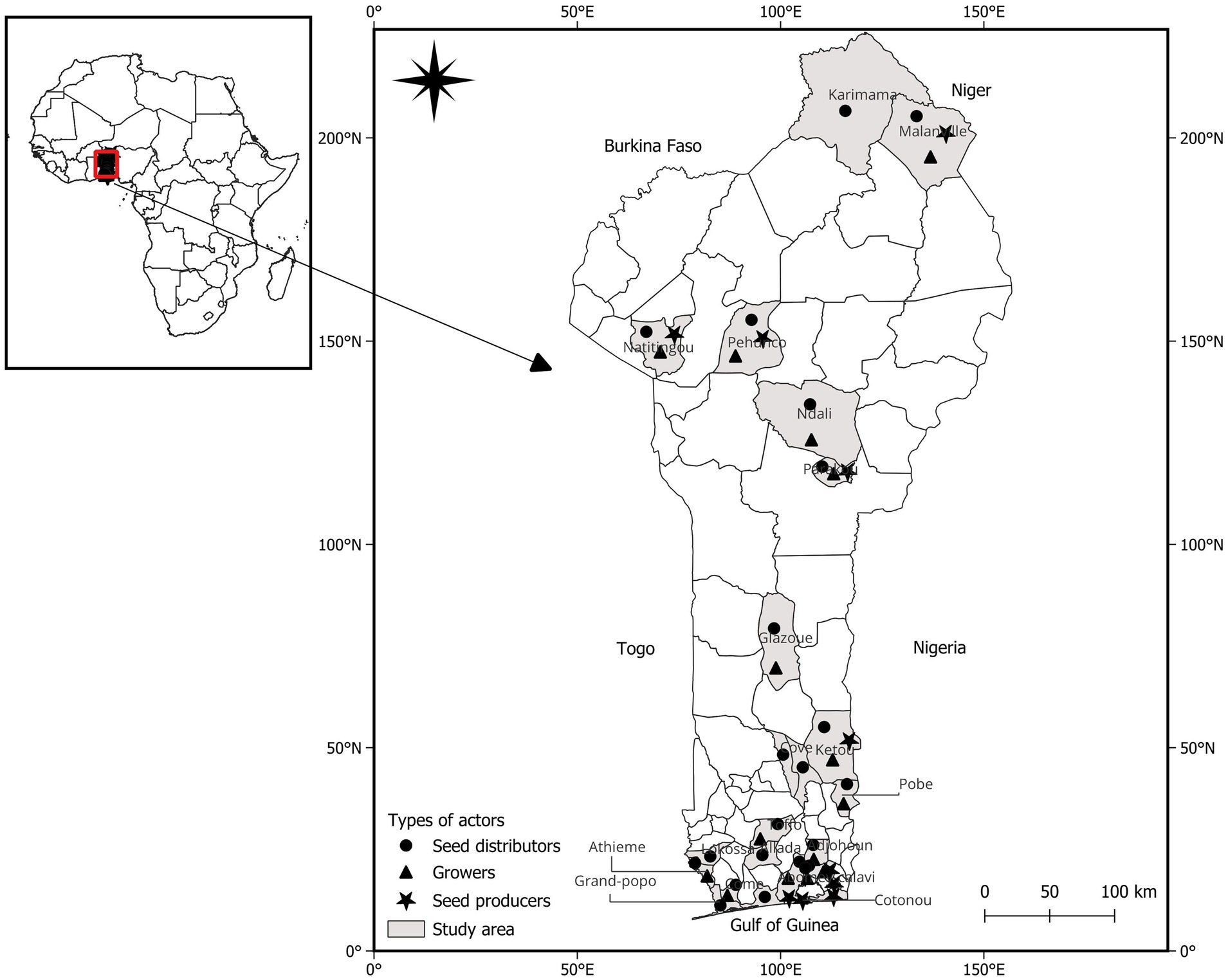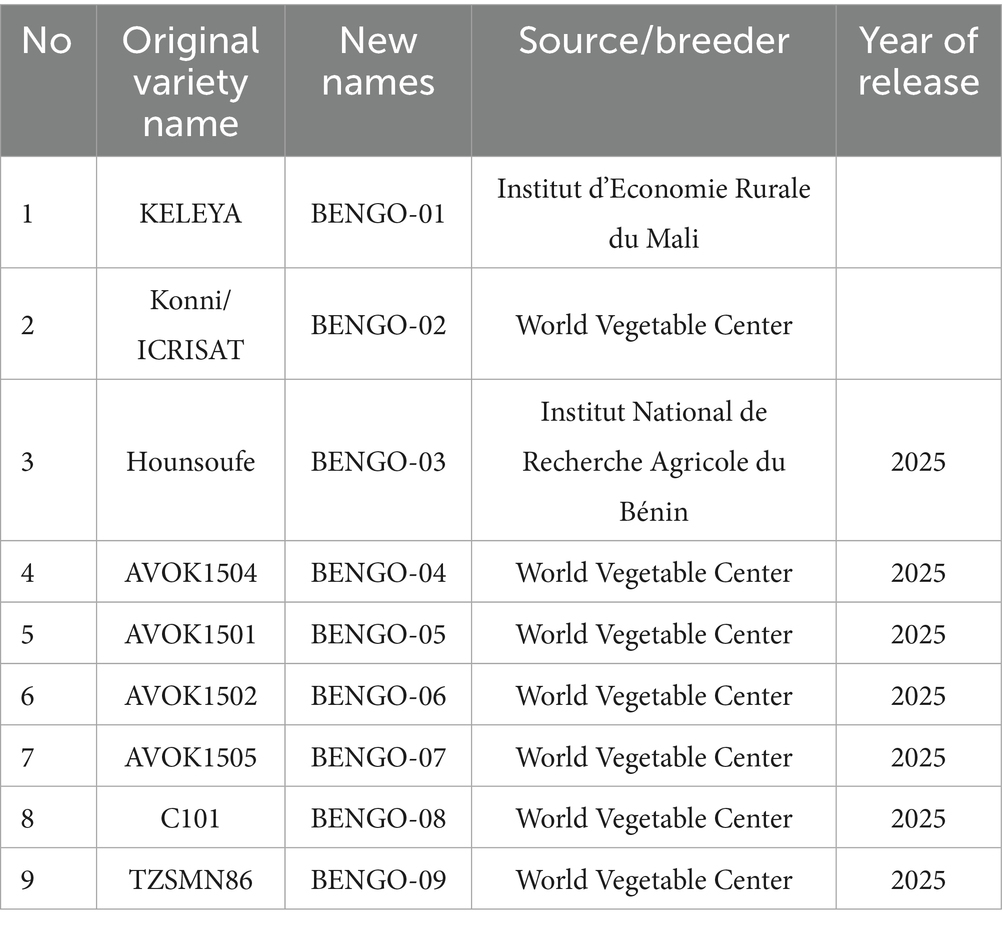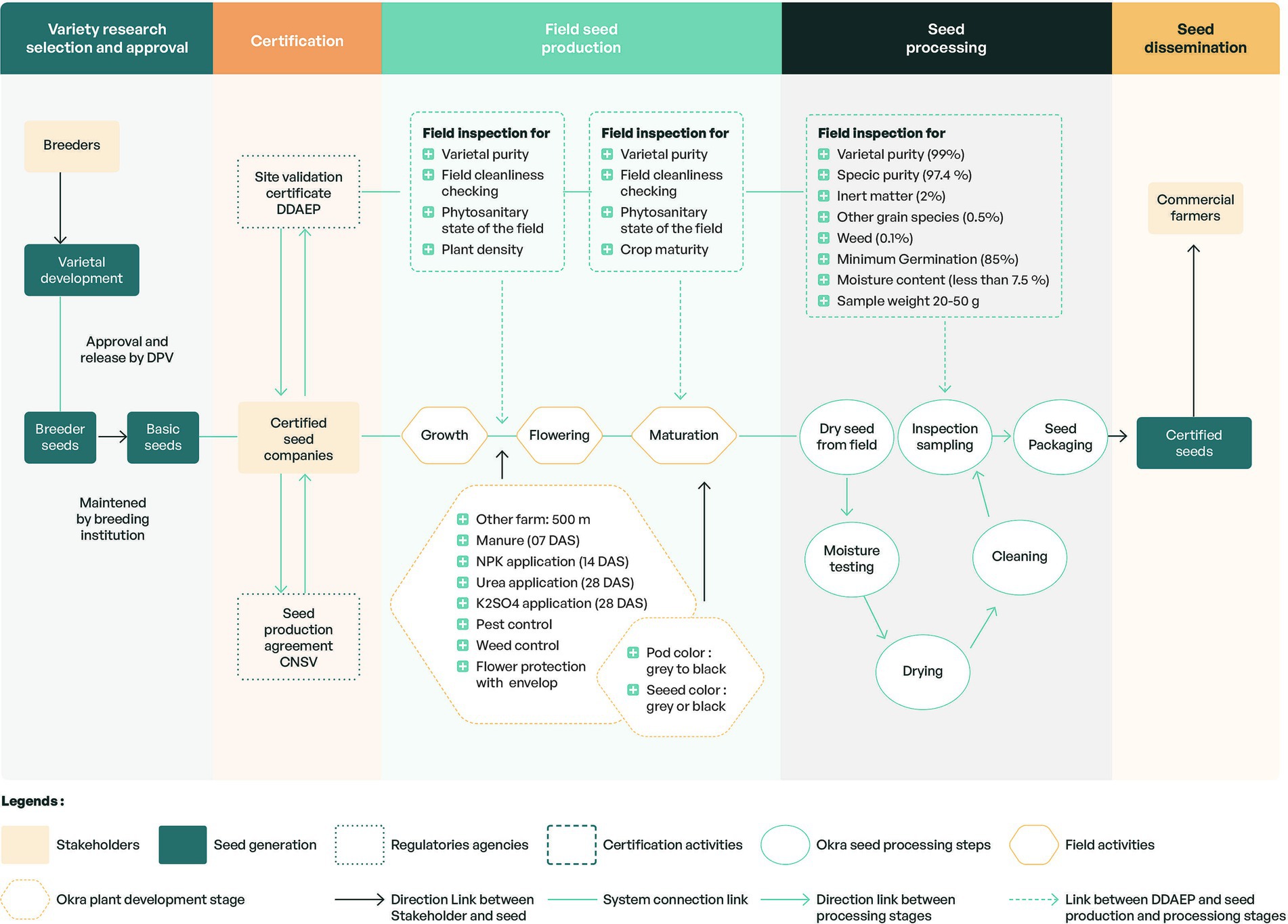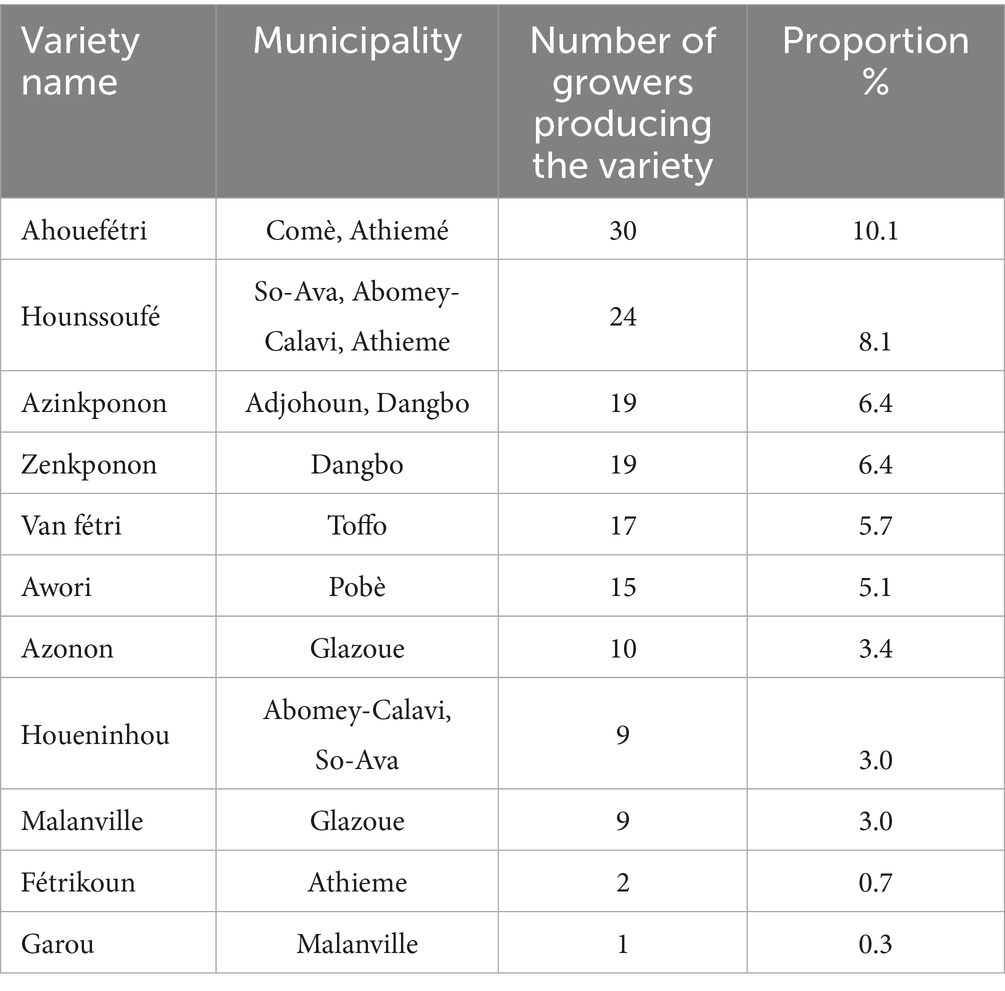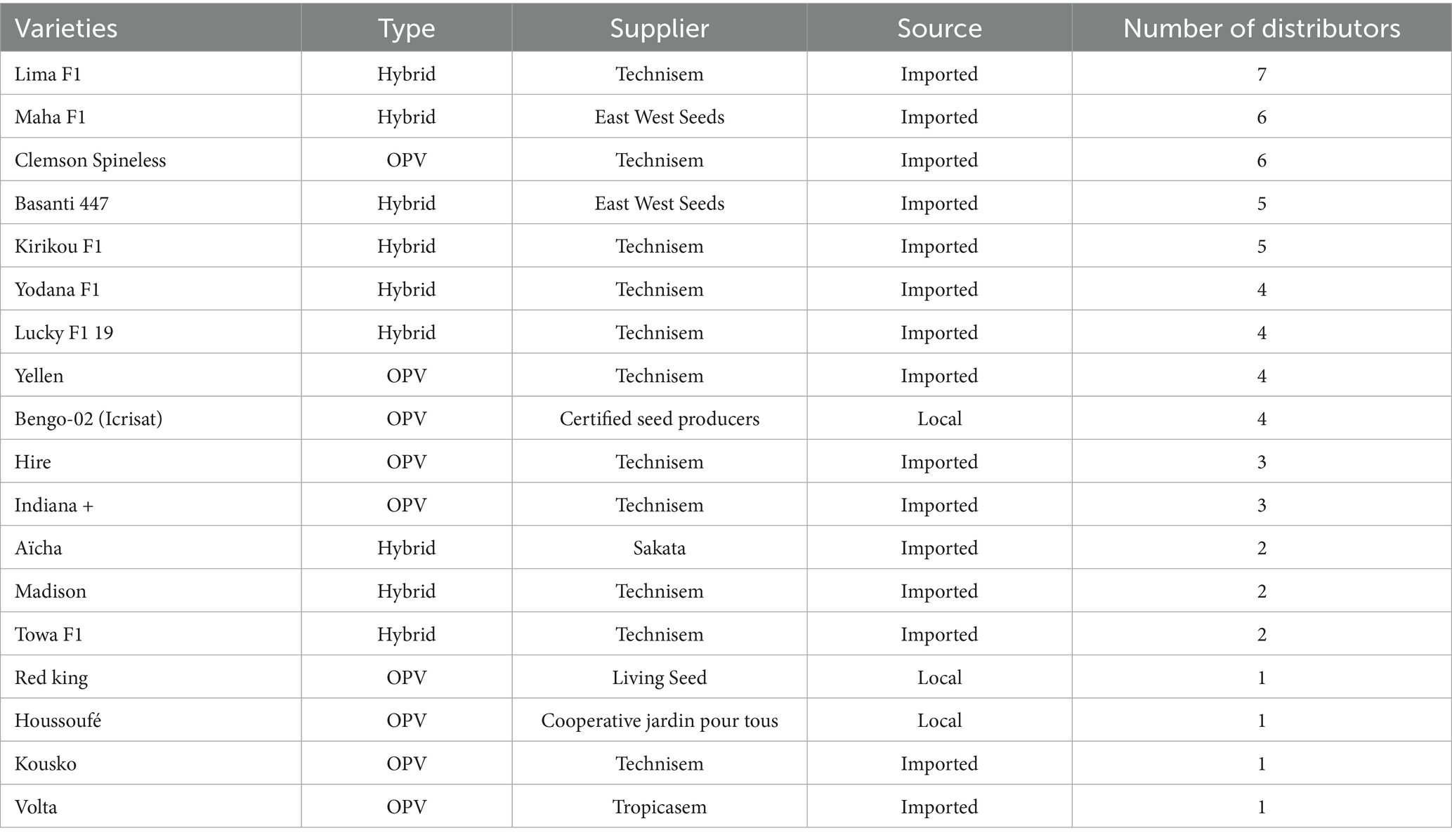- 1Laboratory of Plant Production, Genetics, Biotechnology and Seed Science Unit (GBioS), Physiology and Plant Breeding (PAGEV), Department of Plant Sciences, Faculty of Agronomic Sciences, University of Abomey-Calavi, Abomey-Calavi, Benin
- 2World Vegetable Center, West and Central Africa, Coastal and Humid Region, Cotonou, Benin
- 3World Vegetable Center, Eastern and Southern Africa, Arusha, Tanzania
- 4World Vegetable Center, Mexico Office, CIMMYT Global Headquarters, Texcoco, Mexico
Introduction: Well-functioning seed systems are essential for disseminating improved crop varieties and boosting agricultural production. Understanding their functioning is key to designing tailored interventions. This study analyzed okra (Abelmoschus spp.) seed systems in the Republic of Benin, focusing on seed production, distribution, and constraints affecting the sector.
Methods: A total of 296 okra growers, 79 seed producers, and 34 seed distributors were surveyed using structured questionnaires. Data were collected on seed sources, varieties, quality perceptions, and constraints. Both regulated and farmer-managed seed systems were assessed.
Results: Farmers’ seed systems supplied 90.1% of okra seed, while the regulated system accounted for 9.9%. The regulated system offered 18 varieties (including hybrids and open-pollinated varieties), while the farmer system offered 11 open-pollinated varieties. Respondents valued the germination rate and quality of regulated seed but cited high cost as a major limitation. Other critical barriers included lack of seed quality information, long distances to certified seed sales points, price disparities between imported and local seed, and limited awareness of improved variety performance.
Discussion: To address these challenges, we recommend establishing village-based agro-dealer networks and decentralized seed hubs to improve last-mile delivery in underserved areas. Complementary actions such as on-farm demonstration trials, participatory varietal evaluations, and flexible certification models could enhance farmer awareness, affordability, and seed system inclusivity. While focused on okra in Benin, the structural challenges identified are common in West African vegetable seed systems, offering valuable insights for regional interventions.
1 Introduction
Okra (Abelmoschus spp.) is one of the most consumed vegetables in Africa. Its global production is estimated at about 11.2 million tons, with Nigeria leading the production in Africa (FAOSTAT, 2022). In West Africa, both Abelmoschus esculentus L. Moench and Abelmoschus callei are grown and consumed (Kuo et al., 2022). In Benin, okra ranks as the fourth most cultivated vegetable after tomato, pepper, and onion (DSA, 2021). Both leaves and fruits are consumed, with a predominance of fruit consumption by all sociolinguistic groups in the form of a sticky sauce (Dansi et al., 2008; Achigan-Dako et al., 2010; Achigan-Dako et al., 2011). Okra fruits are rich in protein, minerals (Fe and Zn), and vitamins (Vitamin C and A) (Gemede et al., 2015; Liu et al., 2021). Despite the economic and nutritional importance of the crop, its productivity in Africa is still low, preventing farmers and other stakeholders from taking full advantage of the crop’s potential (Karl et al., 2024). One of the primary constraints to okra production is the poor quality and availability of seeds, a challenge common to many traditional African vegetables (Ayenan et al., 2021; Kansiime et al., 2021). Quality seed is critical in crop productivity as it accounts for nearly 40% of the yield (Wimalasekera, 2015), but Tidjani et al. (2020) found that in the southern part of Benin, okra seeds used in most production systems are of doubtful quality. A sustainable seed system for okra would ensure that high-quality seeds of a number of well-adapted varieties would become fully available on time and affordable to farmers (Kansiime et al., 2021; Ayenan et al., 2022).
A seed system is a set of activities ranging from variety development to seed production and distribution enabling farmers to access the seed they need (Ayenan et al., 2021; McGuire and Sperling, 2016; Sperling and Cooper, 2003). It is a dynamic and complex process with regulatory, institutional, and organizational components. Effective seed systems provide farmers with planting material (1) in sufficient quantities, (2) at the right time, (3) of an appropriate quality (physical, physiological, genetic, and health), (4) of superior genotypes meeting farmers’ needs, and (5) at an affordable price (Louwaars, 1995). There is a diversity of seed systems depending on the crops, regions, and farms as farmers use various channels to access seeds (Almekinders and Louwaars, 2002). Understanding how seed systems function is important to design interventions to improve the production and delivery of high-quality seed to farmers (Sperling and Cooper, 2003). Okra seed systems in Benin are currently poorly documented, preventing the designing of tailored interventions to improve the availability of quality seed to farmers. The present study aims to understand how okra seed is produced, utilized, and distributed to identify entry points for improvement.
In this study, we addressed key questions regarding the okra seed system in Benin: What are the current legal and institutional frameworks governing the system? Who are the key stakeholders, and what roles do they play? Do farmers have access to sufficient seeds at the right time? How do farmers access okra seeds, and what are the main challenges in seed production and distribution? We hypothesized that (i) the weak institutional and regulatory framework negatively impacts the quality and availability of okra seeds in Benin, (ii) farmers primarily rely on farmer seed sources, leading to variability in seed quantity and quality and reduced yields. The main objective of this study was to analyze the current okra seed source, production, and distribution systems in Benin. We specifically (i) assessed the current legal and institutional environments of okra seed system in Benin, (ii) examined the roles of stakeholders involved in the okra seed systems and their relationships, and (iii) assessed the overall status of okra seed systems in Benin.
2 Methodology
2.1 Study area and stakeholder’s sampling
The sampling units of the survey included three groups of actors, namely okra growers, seed producers, and seed distributors. Okra growers were surveyed across fifteen municipalities in Benin, namely Dangbo, Adjohoun, Kétou, Pobè, Abomey-Calavi, Sô-Ava, Toffo, Glazoue, Parakou, Ndali, Malanville, Pehunco, Natitingou, Athieme, and Comè (Figure 1). These municipalities were selected based on their high okra production (DSA, 2021). Besides, the selected municipalities covered major okra production agro-ecologies in the country. In addition to these municipalities, we surveyed seed producers and distributors in Grand Popo, Cotonou, Akpo-Misserreté, Porto-Novo, Ouidah, Zagnanado, Allada, Karimama, Covè and Lokossa.
Growers are farmers who grow okra for commercial and/or home consumption purposes. Seed producers include growers who produce certified or non-certified okra seed. Seed distributors refer to individuals or companies that supply okra seeds to growers, including certified and non-certified seeds as well as imported seeds from international seed companies.
Because of the diversity of the players involved, two sampling techniques were used. Firstly, simple random sampling was applied to obtain a representative sample of okra growers from the overall population. In each of the fifteen targeted municipalities, the local extension services provided a list of the main okra production villages with the total number of okra farmers per village. The number of randomly selected farmers interviewed per municipality was determined based on the size of the grower’s population, with a maximum of 25 farmers. In total, 296 growers were surveyed. Owing to the small population size of seed producers and distributors, we interviewed all available stakeholders of these categories across the country. Seed producers and distributors were identified following discussions with officers from the national seed services and the national agricultural research institute, project staff involved in capacity strengthening of seed producers, and okra growers. We interviewed 79 seed producers and 34 seed distributors.
2.2 Data collection and analysis
Ethical clearance was obtained from the World Vegetable Center Institutional Biosafety and Research Ethics Committee (IBREC ID: 2022-18). Prior to administering the questionnaire, the objective of the study was explained to the respondents, and their consent was obtained. Respondents voluntarily participated in the survey and had the liberty to decline to continue at any point during the interview.
Field surveys were carried out in two phases. The exploratory phase consisted of discussions with the various stakeholders of okra seed systems, which provided valuable information for improving the questionnaire. This phase was also marked by the establishment of contacts with the extension and seed regulatory agency, which played a crucial role in the sampling strategy.
The in-depth study phase was designed to gather comprehensive qualitative and quantitative data on the various players involved in okra seed systems, i.e., okra growers, seed companies, and distributors. These data were collected using questionnaires digitized in the Kobotoolbox platform and administered to the respondents during structured individual interviews. The data collected, both quantitative and qualitative, included the socio-economic characteristics of the farmers (age, socio-ethnic group, gender, level of education, etc.), the seed sources, and questions specific to each stakeholder (including the importance of okra in the growers production system, the sources of seed used in the okra production system, the constraints related to each stakeholder activity, the information related to the seed production system, the okra seed marketed systems, the seed regulations requirements for each stakeholders, the institutional support received by seed producers). The field survey was complemented by a review of seed policy and regulations in Benin to better understand the seed sector’s regulatory, institutional, and organizational framework.
We adapted the classification of Louwaars (1995) to characterize the okra seed systems. The formal seed system here, named as a regulated seed system, is characterized by a structured system including governmental, institutional, or private control of seed. This system involves a chain of activities leading to clear products: certified seed of verified varieties. The informal or farmer seed system is an integrated and locally organized system in which farmers select, produce, disseminate, store, and access seed directly from their own harvest using their own experiences, knowledge, and skills. Seed quality refers to the combination of genetic purity, physical purity, germination capacity, vigor, moisture content, and overall health of seeds. In this study, we also consider perceived germination ability, seedling emergence and vigor, and growth uniformity as an important dimension of seed quality. This perspective reflects how farmers in both formal and informal seed systems evaluate seed quality based on practical outcomes. Seed germination is one measurable aspect of seed quality, referring to the process by which seeds develop into seedlings.
Descriptive statistics were used to highlight the socio-economic characteristics of the respondents. The kernel density estimation (KDE) method was used to analyze and compare the distribution of prices per gram between imported and local varieties and between hybrid and open-pollinated (OPV) varieties. This non-parametric technique was chosen to provide a smoothed visualization of the price distributions. The KDE provides a clearer understanding of how prices are spread within each group without assuming a specific underlying distribution. Survey data were processed in Excel and analyzed using R software version 4.1.2 (R Core Team, R, 2020).
3 Result
3.1 Regulatory framework of the regulated seed system in Benin
The regulated seed system delineates an organized framework that enables farmers to access certified seeds. Governed by policies and regulations at both national and regional levels, this system aims to facilitate the local production and trade of superior seeds within the Economic Community of West African States (ECOWAS) region. The regional regulatory instrument, Regulation C/REG.04/2008, harmonized seed quality control, certification, and marketing rules. Its objective is to promote the production, trade, and availability of high-quality seeds, foster public-private partnerships, and encourage investment in the seed sector (ECOWAS, 2008).
This harmonized regional seed regulation was officially recognized in the Journal officiel de la République du Bénin in August 2013, followed by the formulation of the national seed policy in 2015. The national policy strives to ensure timely and affordable access to quality seeds for farmers, create an enabling environment for varietal development and private investment in the seed sector, promote public-private collaboration, and enhance institutional and legal frameworks. In 2018, Benin enacted Decree No. 2018-173, establishing the Beninese Catalog of Plant Species and Varieties (Le Catalogue Béninois des espèces et variétés végétales CaBEV), defining the role and operations of the Variety Approval and Registration Commission (CHIV). Notably, for vegetable varieties, only the Distinctness, Uniformity, and Stability (DUS) test is required for registration. Additionally, there is provision to release local varieties that have been purified, which is the case for most traditional vegetables that have not benefited from modern breeding. With this provision, the release of local varieties of traditional vegetables can facilitate their inclusion in the regulated system, allowing for seed production, certification, and commercialization. Furthermore, Benin established the National Plant Seeds Committee (CNSV) to oversee seed management, accompanied by the formulation of Technical Regulations for various crops, including traditional African vegetables, marking a significant step towards formalizing seed production.
In terms of intellectual property protection, Benin, as a member State of the African Intellectual Property Organization (OAPI), became a member of the 1991 Convention of the International Union for the Protection of New Varieties of Plants (UPOV) in 2014. However, the implications, in terms of variety protection rights, of this membership for variety protection remain relatively unknown to stakeholders. To operationalize the national seed policy, the Plant Production Department developed the National Strategy for the Development of the Plant Seeds Sub-sector 2022–2026 in 2021. However, current regulatory provisions pertaining to seeds primarily emphasize the regulated system, failing to account for the plurality of seed systems. In 2024, the government issued Decree No. 2024-723 of January 24, 2024, establishing the Beninese Society for the Development of Seeds and Plants and approving its statutes (Figure 2). This decree specifically aimed at strengthening the formal seed sector, with a mandate focused on the production, regulation, and promotion of certified seeds in accordance with national and ECOWAS seed regulations.
3.2 Okra seed certification process
Seed certification is a process to ensure marketed seeds are genetically pure and of good quality. In Benin, variety registration is compulsory, and seeds may only be put on the market if they are certified. Only two okra varieties were certified in 2023, namely ICRISAT and Keleya, but none of them were included in the national seed catalog. In March 2025, 7 other varieties were approved for release and registration in the national catalog (Table 1).
In the seed certification scheme (Figure 3), different seed classes are designated, such as breeder seed, foundation or basic seed, and certified seed. Breeder seed is produced and controlled by plant breeders from research institutions such as the World Vegetable Center and the Laboratory of Genetics, Biotechnology, and Seed Science. Foundation seed is the seed produced from the breeder seed, and the National Institute of Agronomic Research (INRAB) has the exclusive mandate to produce this seed class. Field inspections are conducted by the seed certification agency (DPV). Seed companies, individuals, and cooperatives, with a seed production agreement issued by the Ministry of Agriculture, produce certified okra seed. During okra seed production, four inspections are performed by the quality control officers to ensure that the seed production standards and regulations are met: (i) before planting, to validate the choice of the seed multiplication site; (ii) before flowering, to ensure varietal purity, the cleanliness and the phytosanitary state of the field, as well as the planting density are checked, and (iii) at flowering stage, to check variety purity, field cleanliness, phytosanitary stage on the field plant maturity and (iv) at maturity stage, to check physiological maturity. Okra seed processing activities include drying, cleaning, moisture content testing, and packing. Before packing, a sample of seeds (20–50 g) is collected by the DPV officers for quality control at the laboratory. The following testing parameters and thresholds are applied for certified seed: (i) germination and disease-free conditions, (ii) varietal purity 99%; (iii) specific purity 97%; Inert matter (2%), contamination with other grain species less than 0.5%; seeds of weeds less than 0.1%; a minimum germination rate of 85%, and a moisture content of less than 7.5%.
3.3 Socio-economic characteristics of okra seed system actors
The descriptive analysis of the demographic and socioeconomic factors revealed differences among the actors involved in okra seed systems (Table 2). More than 50% of the respondents completed at least primary school and had a good experience in okra production (>10 years), okra seed production (>13 years), and okra seed distribution (>10 years). The okra seed sector is dominated by men, with an average age of 44 and 41, respectively, for seed producers and growers. Seed distributors have been in the business for an average of 21 years and 10 years in the okra seed distribution business.
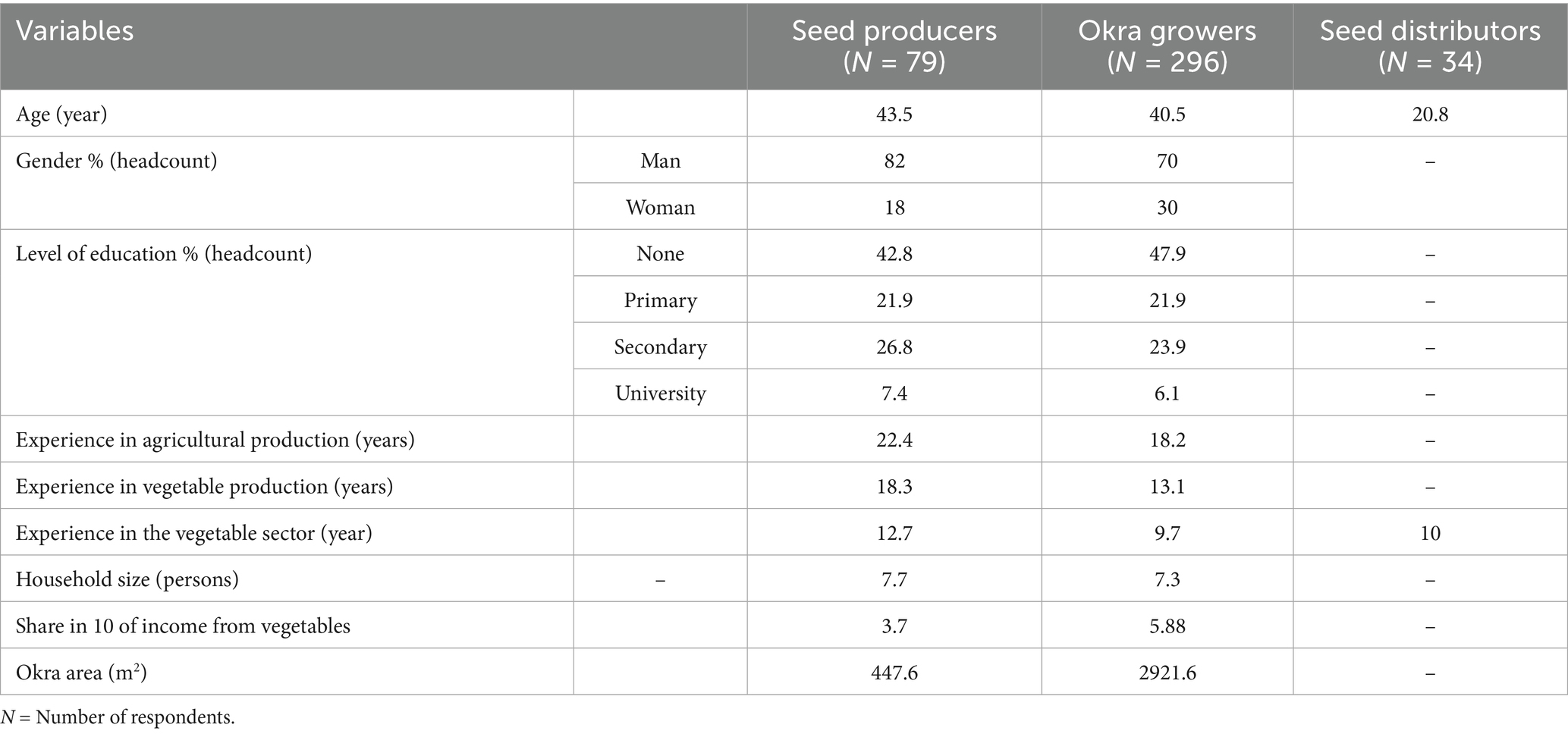
Table 2. Socio-economic characteristics of the respondents (seed producers, seed distributors, farmers).
3.4 Description of the okra seed systems in Benin
The okra seed systems in Benin were organized into the “regulated” seed system (also referred to as formal seed system) and the “farmer” seed system, also known as “informal” or “traditional” or “local” seed system (Figure 4). The regulated seed system supplied 9.9% of the seed used by okra growers of which 0.3% were locally produced and certified seeds while the rest was imported. The farmer seed system is composed of okra farmers who produced and saved seed for reuse or exchanged and bartered seed with friends, neighbors, and relatives and purchased seed in local markets. The farmer seed system represented 90.1% of the okra seed, with the majority (65.5%) of growers utilizing seeds harvested from their crop, and 20.3% purchasing seed in local markets. Farmers harvested seeds from pods they intentionally left on plants for maturity and drying, and the dried pods were harvested for seed extraction and storage.
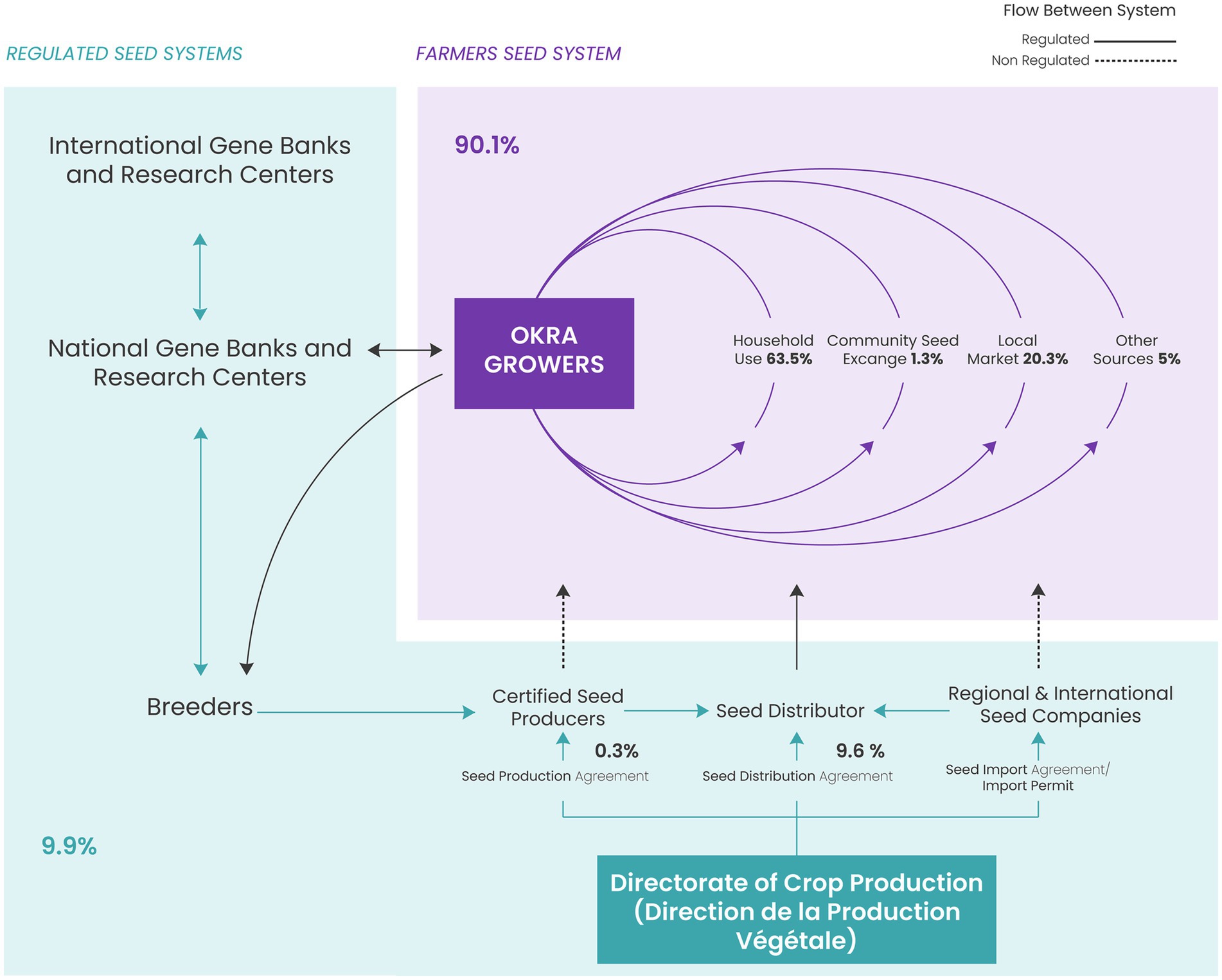
Figure 4. Okra seed system in Benin showing the farmer seed system (purple frame), the regulated seed system (light blue frame), and the flow between systems.
3.5 Okra production and cropping systems
3.5.1 Importance of okra production and seed characteristics
Growers in Benin produced okra both for sale and for self-consumption. The leaves were sold by a fifth of the surveyed farmers. Okra production accounted for almost half of the grower’s income from vegetable production, and the production area per farmer was on an average 4,153 m2. Most producers cultivated okra once a year (one production cycle per year), while 37.5 and 9.8% planted twice and thrice, respectively. Most okra growers (90%) used local varieties (Table 3), while only 10% produced improved varieties.
Around 59% of respondents could not identify the specific variety they cultivated. Merely 5% of producers knew the genetic characteristics (variety name, expected yield, trait of interest, etc.) of the varieties they cultivated. Most growers (77%) stored seed for reuse using different packaging methods (Figure 5), with 27% using plastic bags (Figure 5A). Purchased seeds from shops were packed in Aluminum bags or other containers and included information on the variety (Figures 5E,G).
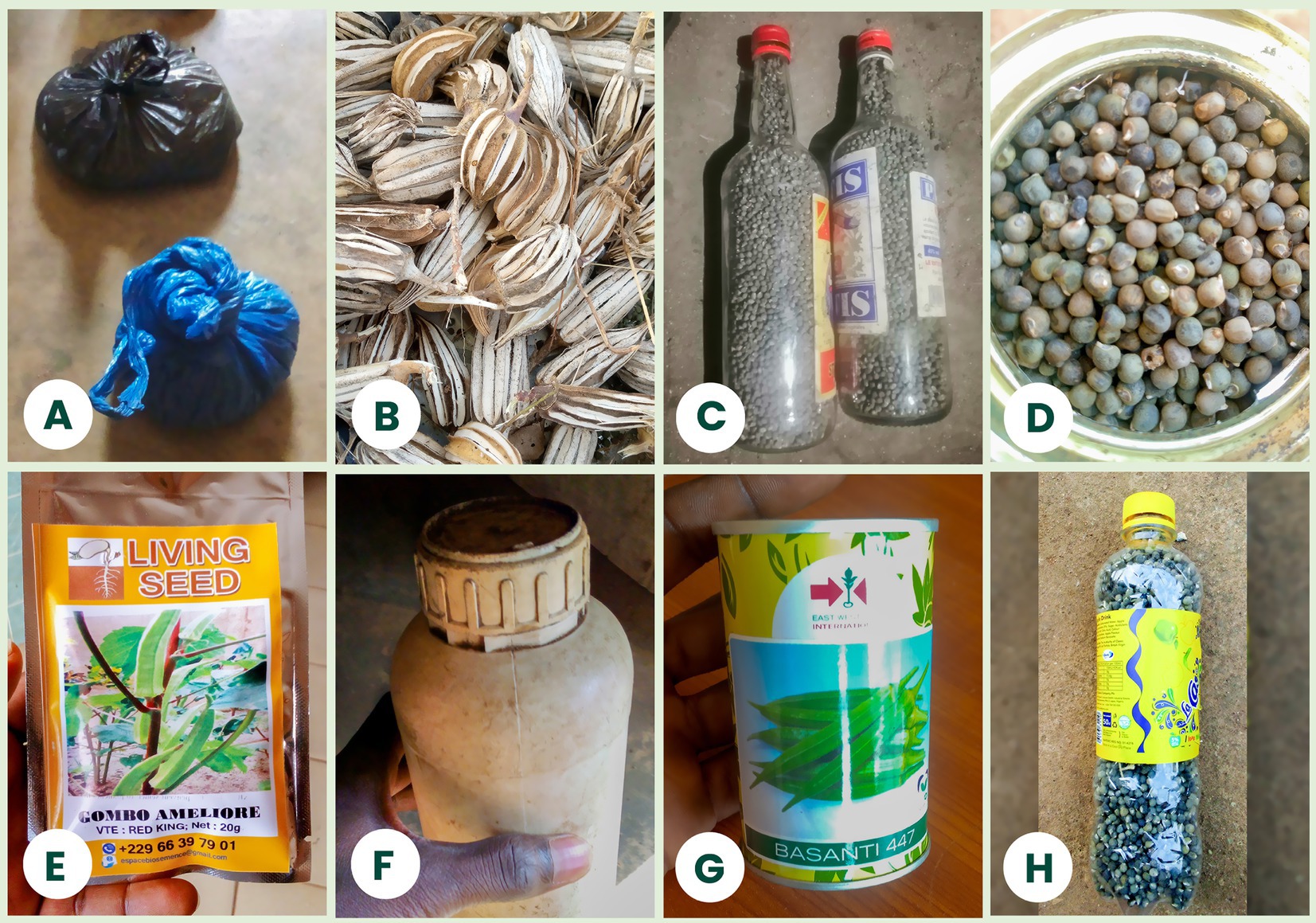
Figure 5. Diversity of okra seed packaging used or purchased by growers in Benin. Different farmers’ packaging methods for storing and distributing okra seeds, ranging from informal local practices to commercial packaging. (A) Tied plastic bag, (B) dried okra pods, (C) glass bottles with seeds, (D) open metal container with seeds, (E) branded aluminum seed package with a logo, (F) reused insecticide bottle, (G) branded aluminum seed package with a logo, (H) reused plastic bottle.
3.5.2 Okra growers’ perception of the quality and germination rate of okra seeds from different sources
We assessed farmers’ perceptions of overall seed quality and germination rates from various sources and found that these perceptions revealed distinct satisfaction levels (Figure 6). Certified seed growers stood out, with 95% of respondents considering their seeds to be of “Good” or “Very Good” quality. Seeds from distributors were rated positively by approximately 70% of farmers, whereas gifts and local market seeds had a lower proportion of high ratings, with only 40% receiving “Good” or “Very Good” feedback. Own-produced seeds had varied perceptions, with 45% categorized as “Good,” 30% as “Very Good,” and the remaining 25% as “Not Good.” These findings highlight the need for enhanced quality control and assurance, particularly for seeds sourced from informal markets and personal production.
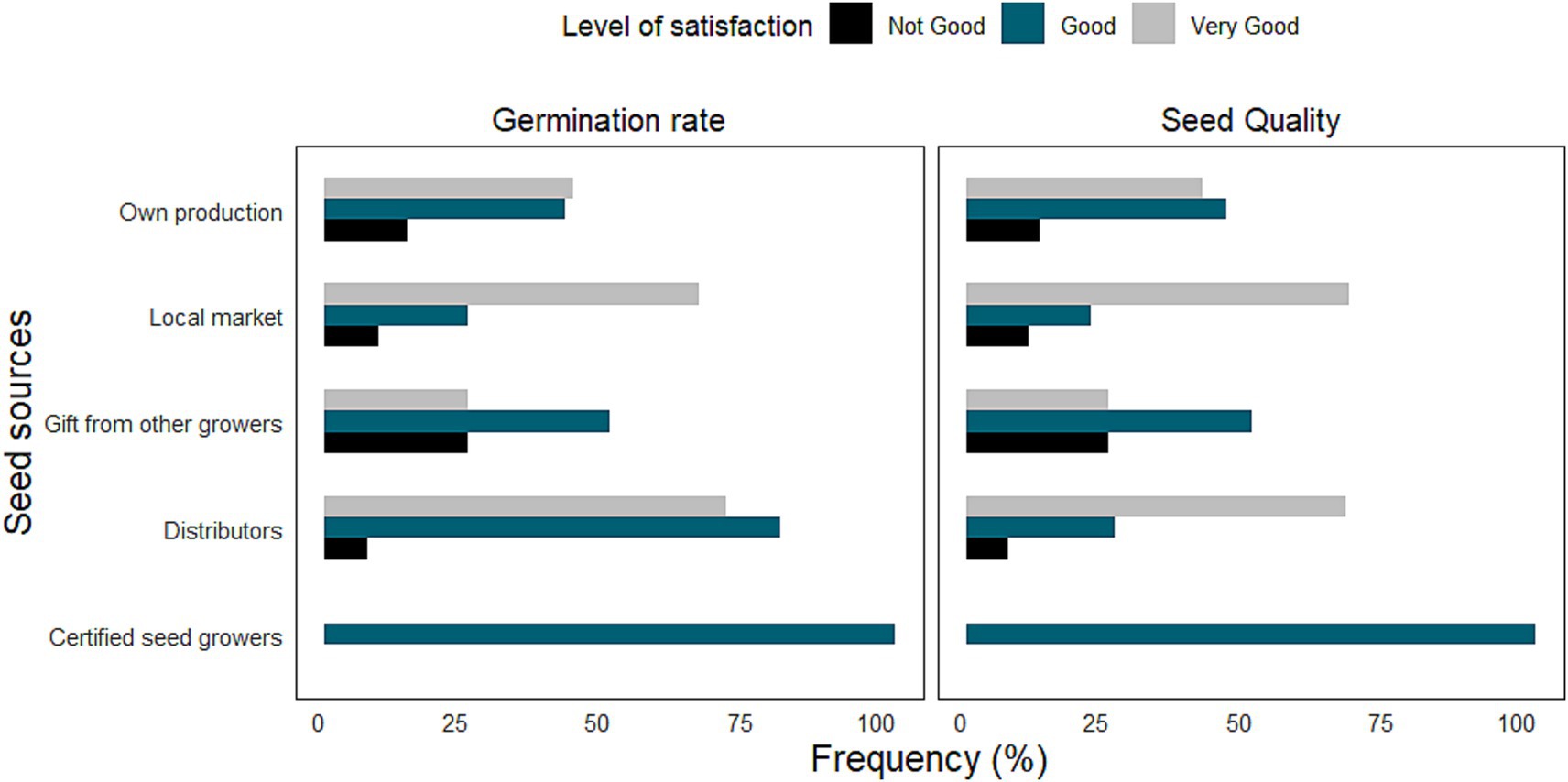
Figure 6. Frequency of farmers’ perception of the quality and germination rate of seeds according to the sources of provenance.
Regarding seed germination rate, certified seed growers received the highest ratings, with approximately 100% of respondents categorizing their seeds as “Good.” Distributors followed closely, with around 75% of farmers rating their seeds as “Good” and an additional 15% as “Very Good.” In contrast, seeds obtained as gifts from other growers or from the local market were perceived as of lower quality by okra growers in terms of germination rate, with only about 30% of respondents rating them as “Good” and nearly 20% as “Not Good.” Seeds from own production exhibited a mixed response, with 50% of farmers giving them a positive rating and 25% rating them as “Not Good.”
3.5.3 Challenges encountered by okra growers
Several factors hindered okra production, with low market access (77%) and disease pressure (68.9%) being the most frequently cited (Table 4). These challenges indicate significant barriers to both productivity and farmers’ income. Additionally, seed unavailability (29.7%) and lack of quality seed (17.6%) suggest difficulties in accessing reliable planting material. Difficult access to inputs (6.4%) and limited knowledge on crop production (13.2%) highlight gaps in resource availability and agronomic expertise.
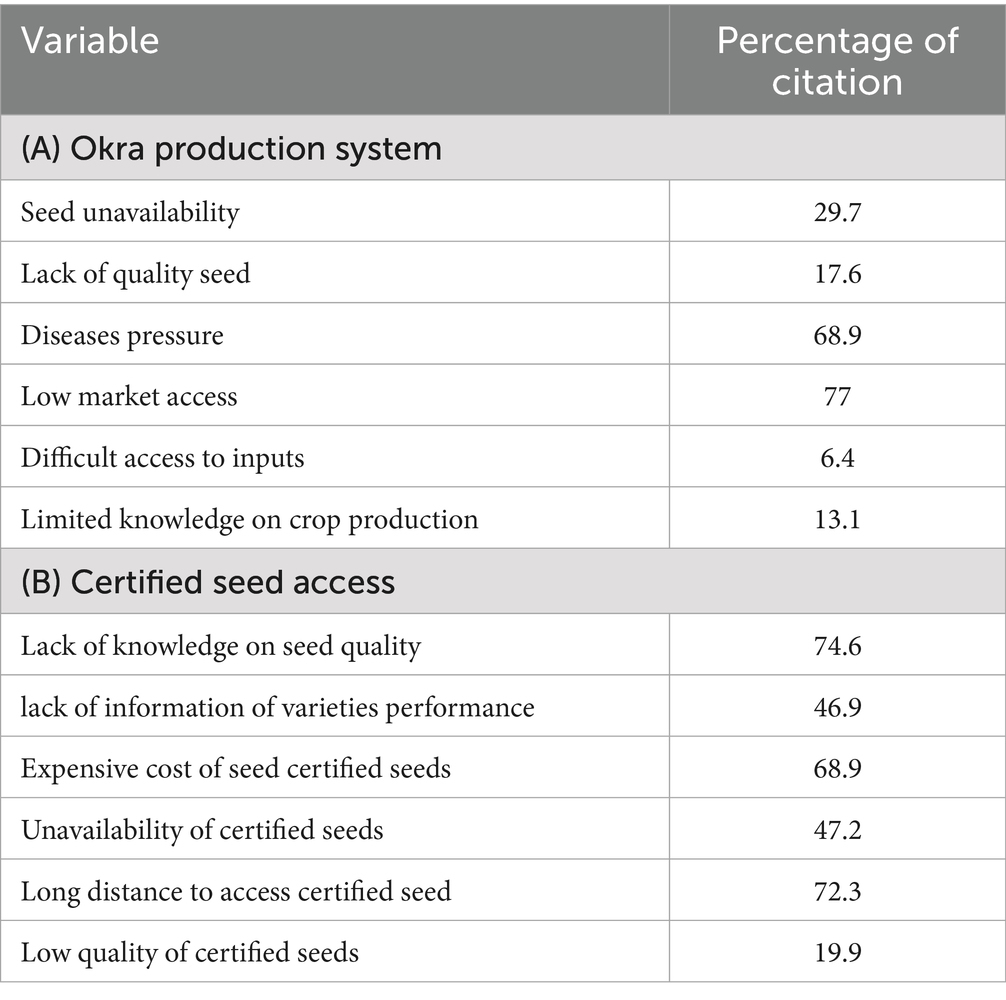
Table 4. Main challenges encountered by okra growers in (A) their production system (B) accessing certified seeds.
The most prominent issue in accessing certified seed is lack of information on seed quality (74.6%), followed by long distance to access certified seed (72.3%). These findings indicate that farmers face challenges in both understanding seed quality standards and overcoming logistical barriers to obtaining certified seed. Cost and availability also play a significant role. The expensive cost of certified seeds (68.9%) and unavailability of certified seeds (47.2%) create additional barriers to adoption. Furthermore, lack of knowledge on variety performance (46.9%) suggests that even when certified seeds were available, farmers might not fully understand their benefits, limiting their widespread use. Interestingly, low quality of certified seeds (19.9%) was mentioned less frequently, indicating that while some farmers perceived quality issues, the main barriers to adoption were related to broader accessibility challenges including affordability and limited knowledge.
3.6 Okra seed production systems
3.6.1 National okra seed production
Local okra seed production in Benin is ensured by certified and farmer seed producers, representing 48 and 52% of the respondents, respectively. Certified seed producers had a seed production authorization or produced released varieties and were recognized by the DPV (Directorate of Crop Production). Seed producers in the farmer seed system were okra producers who sold their seeds without quality control by the seed certification services. Certified okra seed production in Benin had increased from 81.5 kg in 2019 to 548 kg in 2022, with an unexpected decrease to 195 kg in 2023 due to a shortage of foundation seed and the lack of resources from certification agencies to carry out seed certification activities. Production of early-generation seed (pre-basic and basic seed) and certification activities were project-dependent. The current production capacity of certified seeds remains inadequate to satisfy the demand for okra seeds within the country.
3.6.2 Characteristics of okra seed production systems
All interviewed certified seed producers specialize solely in vegetable seed production. Conversely, farmer seed growers also produced other types of seeds, including cereals (27%), root and tubers (56%), and legumes (39%). Seed produced predominantly produced tomato, pepper, and African leafy vegetables seed.
All certified seed producers surveyed sold seeds in shops, unlike most (95%) farmer seed growers, who sold seeds in their homes. Seeds from certified seed producers were sold in retail and wholesale, while most farmer seed (54%) was sold in retail. All certified seed producers worked with a distribution network comprising shops conversely to farmer seed okra seed growers who had no distribution network and sold their seed at the farm gate. Furthermore, all certified seed producers used communication channels such as WhatsApp, Facebook, phone calls, and word-to-mouth to market their seed. All certified seed producers marketed seeds in packaging and per gram, while farmer seed producers used packaging (19%), weight (29%), and others (51%), including plastic bags and bottles.
Okra seeds were produced once a year by all certified seed producers (100%) and twice a year by 74% of farmer seed producers. The variety ICRISAT (Konni) and local and unknown source okra varieties, were produced by 100, 50, and 58% of certified seed producers, respectively. All certified seed producers (100%) sourced their foundation seeds from INRAB, while most farmer seed producers (98%) re-used their seed. All certified seed producers (100%) select okra seeds based on criteria such as pod size, pod color, flowering period, and number of fruits per plant. The number of fruits per plant constitutes the seed selection criterion used by most farmer seed producers (95%). All certified seed producers (100%) used pod color and time to maturity after sowing as selection criteria for seed maturity, while most farmer seed producers (54%) used pod color. Standing drying (letting the okra pods dry on the plant before harvest) and other methods constitute the seed drying techniques used by all certified seed producers, while all farmer seed producers used standing drying and post-harvest drying. All seed producers, both certified and not, let okra pods dry in the field for 1–2 weeks. All certified seed producers (100%) used aluminum packages, while most farmer seed producers (95%) used other packages as described in the previous section.
None of the seed producers surveyed had a seed extractor, seed cleaner, seed separator, or seed quality laboratory. However, all certified seed producers had, on average, three trays for seed drying and a sealer for seed packaging. Only one certified seed producer also had a temperature-controlled seed storage. All certified seed producers and 19% of the farmer seed producers received technical support from projects. Specifically, the technical support consisted of training on good agricultural practices (GAP), varietal purity maintenance, field isolation, integrated pest and disease management, optimal harvesting techniques, seed drying, packaging, and storage. In some cases, seed producers were also trained in basic business management and record-keeping practices to strengthen their seed production enterprises. This support was provided through various development projects, including, among others, the SAFEVEG project (Local Production of Safe Vegetables for West African Consumers), the TAAT program (Technologies for African Agricultural Transformation), the EJASA project (Youth Employment for the Improvement of Food Security in Northern Benin). These initiatives aimed to improve seed quality, enhance technical capacity, and foster more sustainable seed systems.
3.6.3 Challenges in okra seed production across regulated and farmer seed systems
The most frequently cited constraint in both the regulated (97.6%) and farmer (100%) seed production systems was the lack of appropriate facilities for seed production. In the regulated system, limited access to improved varieties and high certification costs were also commonly reported. While these constraints were specific to the formal system, some farmer seed producers expressed aspirations to access improved planting materials or participate in formal processes but lacked the resources or institutional support to do so. Additionally, limited access to foundation seed produced exclusively by the national agricultural research institute (Institut National des Recherches Agricoles: INRAB) was cited as a key constraint by 70.3% of certified seed producers. Farmer seed producers, while not engaged in formal seed classes, also reported difficulties in accessing reliable seed stock to initiate or maintain their own seed production. These findings highlight cross-cutting barriers that require coordinated institutional and policy-level responses.
Financial limitation was another major barrier. The low access to credit for investment (70.4% in regulated seed system and 68% in farmer seed system settings) and the lack of financing for seed business expansion (22.7% in regulated seed system and 100% in farmer seed system settings) highlight the critical role of access to capital in improving seed production.
Technical and infrastructural limitations were reported as significant challenges. The lack of qualified seed production personnel understood here as individuals with basic technical knowledge or informal training in seed production practices was mainly reported by seed producers in the farmer seed system (82.5%), compared to 25.4% in the regulated seed system. This indicates that while capacity gaps exist in both systems, they are more acute in informal settings where access to training and extension support is limited. Similarly, the lack of suitable equipment for okra seed processing was reported by 100% of farmer seed producers and 21.4% of those in the regulated system, highlighting a significant disparity in access to appropriate technology, particularly for small-scale producers operating outside the formal seed framework.
Access to inputs remains a concern, though with varying degrees of recognition. Access to inputs poses greater challenges for seed producers in the farmer seed system (62.3%) compared to regulated seed system (12.2%). These inputs include not only early generation seeds but also fertilizers, crop protection products, irrigation tools, drying trays, and basic packaging materials resources that are often essential for ensuring the quality and viability of produced seeds. This indicates that smallholder farmers and seed producers in these systems face difficulties in acquiring essential materials. In contrast, issues with access to reliable water sources for irrigation were more prevalent in regulated seed settings (21.9%) than in farmer seed systems (10.5%). This disparity may reflect variations in production scales and reliance on irrigation (Table 5).

Table 5. Main challenges in okra seed production system in regulated seed system and farmer seed system sector.
3.7 Okra seed distribution system
3.7.1 Characteristics of okra seed suppliers
Seed distribution was the main activity of the respondents (73%). Seed distributors included informal local businesses (50%), formal local businesses (41%), cooperatives (6%), and regional companies (3%). All distributors sold tomato and pepper seeds year-round, while onion, cucumber, and traditional vegetable seeds including okra were supplied by 29, 59, and 88% of distributors, respectively. Most seed distributors (82%) did not have any mechanism to forecast farmers’ seed needs. Okra seed was imported by 15% of the distributors in the country. Most okra seed distributors (70%) sourced locally available okra seeds.
All the distributors sold seed directly to farmers. Distributors also supplied farmer cooperatives (29%), retailers (18%), and institutional buyers (Governmental organizations and NGOs) (15%). Most seed distributors (70%) operated without a formal distribution authorization. The seed distributors expressed dissatisfaction with Benin’s current regulatory framework for seed distribution. In fact, they mainly highlighted the regulation process, which was perceived as complex and expensive. Furthermore, all seed distributors (100%) reported increased interest in marketing locally produced okra seeds.
3.7.2 Okra seed distributors’ perceptions regarding the quality of okra seeds from different sources
Figure 7 presents a comparative analysis of distributor satisfaction levels with imported and local okra seeds across three key dimensions: (i) reliability (defined as the degree to which a seed consistently performs well across seasons and environments particularly in terms of germination, vigor, as well as the distributor’s trust in its source and production quality), (ii) affordability (referring to a cost a farmer pays to purchase seeds), and (ii) quality (referring to the physical, genetic, physiological, and health attributes of seeds at the time of purchase). The responses are categorized into Not Satisfied, Satisfied, and Very Satisfied, with their respective frequencies expressed as percentages. Overall, imported seeds were valued for their quality and reliability but considered costly, while local seeds were preferred for their affordability despite concerns over consistency.
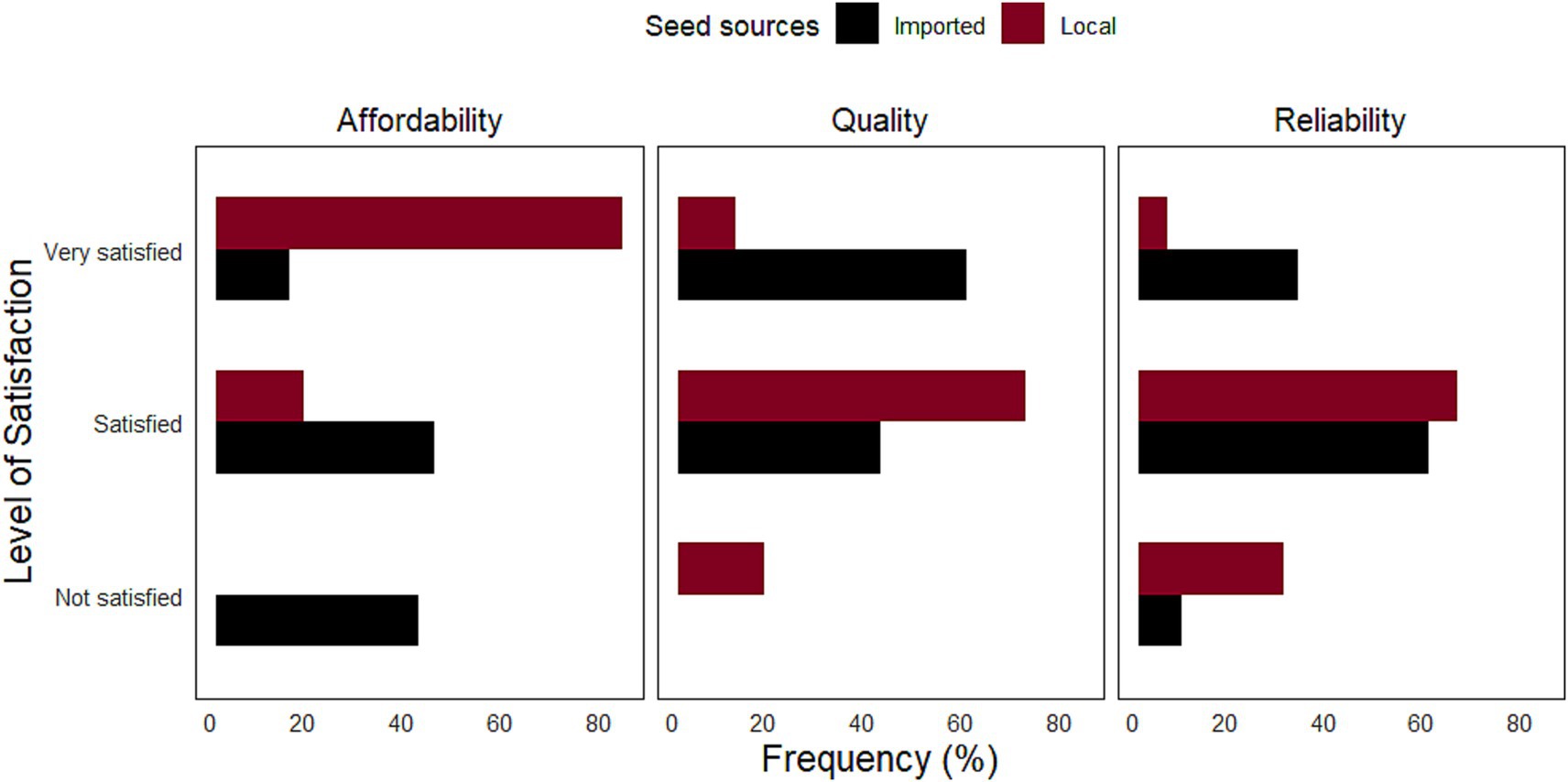
Figure 7. Comparison of seed distributors satisfaction with imported vs. local seeds based on reliability, affordability, and quality.
Reliability is a critical factor influencing the adoption of a variety, as it affects germination rates, vigor, and consistency in crop performance. 60% of distributors were satisfied with imported okra seeds, while 65% expressed satisfaction with local seeds. A higher proportion of distributors (30%) were very satisfied with imported seeds, whereas only 10% indicated the same for local seeds. 25% of distributors expressed dissatisfaction with local seeds, compared to 10% for imported seeds, suggesting potential inconsistencies in germination rates or performance variability.
The affordability of seeds influences farmers’ purchasing decisions and, consequently, distributor preferences. About 45% of distributors expressed dissatisfaction with the price of imported seeds, indicating that these seeds are perceived as expensive. In contrast, 70% of distributors were very satisfied with the price of local seeds, reinforcing their affordability and accessibility. Only 15% of distributors reported being very satisfied with the price of imported seeds, further highlighting the economic barrier associated with these varieties.
Seed quality encompasses attributes such as purity, genetic integrity, resistance to pests and diseases, and uniformity in growth. 45% of distributors were very satisfied with the quality of imported seeds, compared to 25% for local seeds. However, 55% of distributors were satisfied with the quality of local seeds, demonstrating a general acceptance despite certain limitations. The proportion of distributors dissatisfied with local seed quality (20%) was slightly higher than for imported seeds (15%), potentially reflecting concerns over seed consistency or performance variability.
3.7.3 Source and type of okra seed supply by seed distributors
Okra seeds distributed in Benin via the regulated seed system were mostly imported seeds from foreign seed companies such as Technisem, East West Seed, and Sakata. Technisem is the leader in terms of the number of varieties available (11 varieties out of the 18 listed, including 55% hybrids). The other international seed companies, namely East West Seed and Sakata, distributed hybrid varieties through seed distributors. Local seed companies (Living Seed, Cooperative Jardin pour Tous) marketed open pollinated local varieties, and certified seed producers sold locally produced seed of Icrisat (Bengo-02) okra variety (Table 6).
3.7.4 Okra seed price analysis
Figure 8 examines the prices of okra seeds (XOF per gram), with a focus on the type of variety: hybrid versus open-pollinated varieties (OPV). In Figure 8A, a bar plot illustrates the average price per gram for each type of variety, with error bars indicating the variability in prices. The findings indicate that hybrid varieties, including Madison, Maha F1, and Clemson Spineless, consistently command higher average prices, approximately 150 XOF per gram (around $0.25 USD per gram). In contrast, OPV varieties, like Houssoufè and Icrisat, are available at lower prices, approximately 30 XOF per gram (close to $0.05 USD per gram).
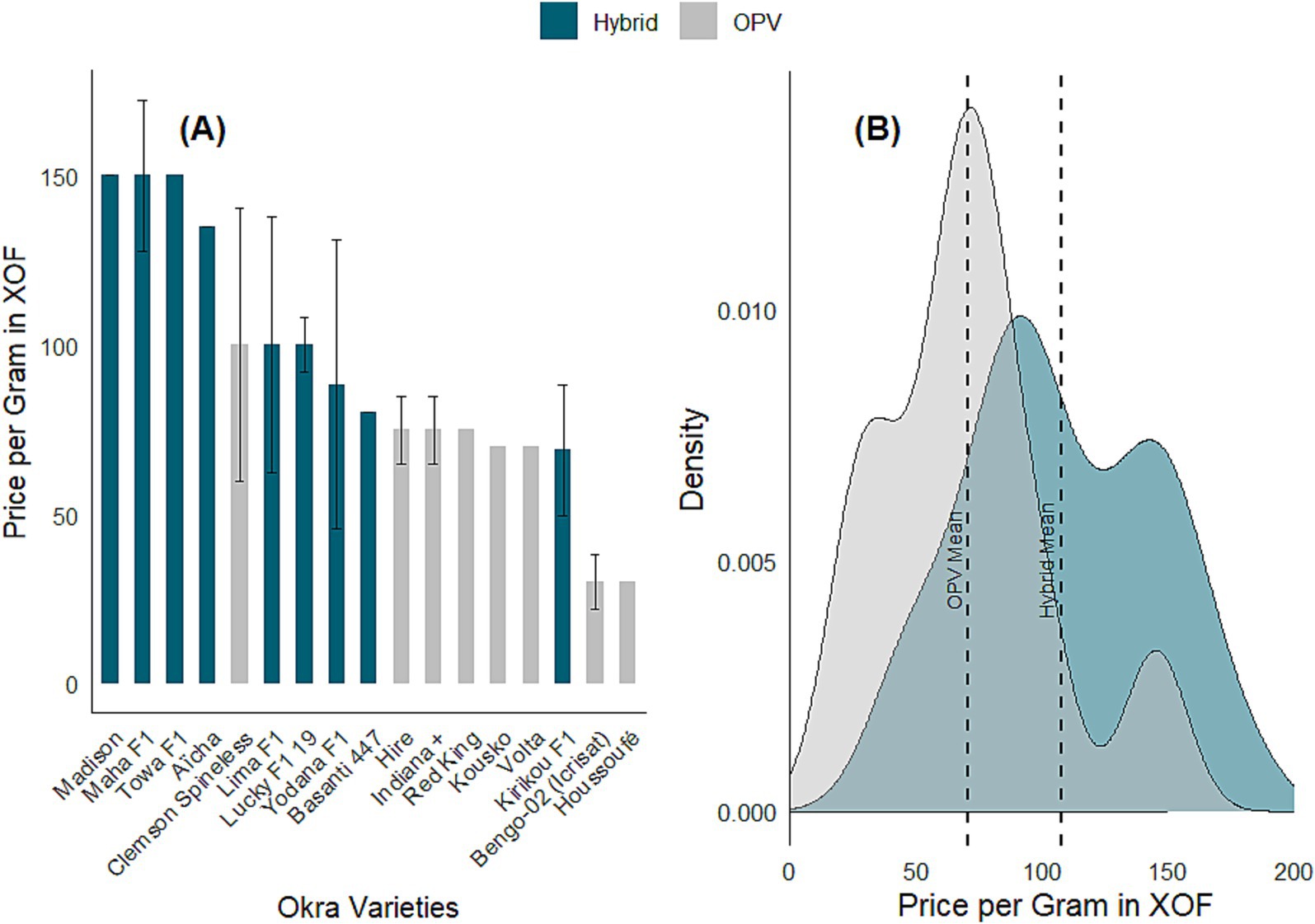
Figure 8. Okra seed price variation by variety type (Hybrid vs. OPV). (A) Mean price per Gram by variety type. (B) Kernel density distribution of prices by variety type.
The kernel density distribution for seed prices by type, illustrated in Figure 8B, indicates that hybrid seeds have a wider and more right-skewed price distribution, implying a larger variety in prices and a notable occurrence of higher-priced options. In contrast, OPV prices are more concentrated in the lower price spectrum, which reflects higher affordability and consistency in pricing. Furthermore, hybrid seeds exhibit a significantly higher average price compared to OPVs, highlighting the price disparity between the two seed types.
These findings emphasize the financial challenges that hybrid seeds can create for smallholder farmers, particularly in areas with restricted access to subsidies or funding for seeds. Although hybrids may provide certain agronomic benefits, like increased yields or resistance to diseases, their elevated cost could hinder adoption by farmers with limited resources. Conversely, the lower and more consistent pricing of OPVs suggests they are more accessible, although this may come with trade-offs in some performance characteristics. These observations underscore the necessity of finding a balance between affordability and effectiveness in the development and distribution of okra varieties.
Figure 9 illustrates a comparative examination of okra prices (XOF per gram) among different varieties in the Beninese market, distinguished by their origin: either imported or locally produced. In Figure 9A, a bar graph displays the average price per gram for each source, with error bars representing the variability in prices. Imported varieties, particularly Madison and Maha F1, demonstrate significantly higher average prices, reaching about 150 XOF per gram (approximately $0.25 USD per gram). Conversely, local varieties like Houssoufè exhibit an average price of roughly 30 XOF per gram (about $0.05 USD per gram).
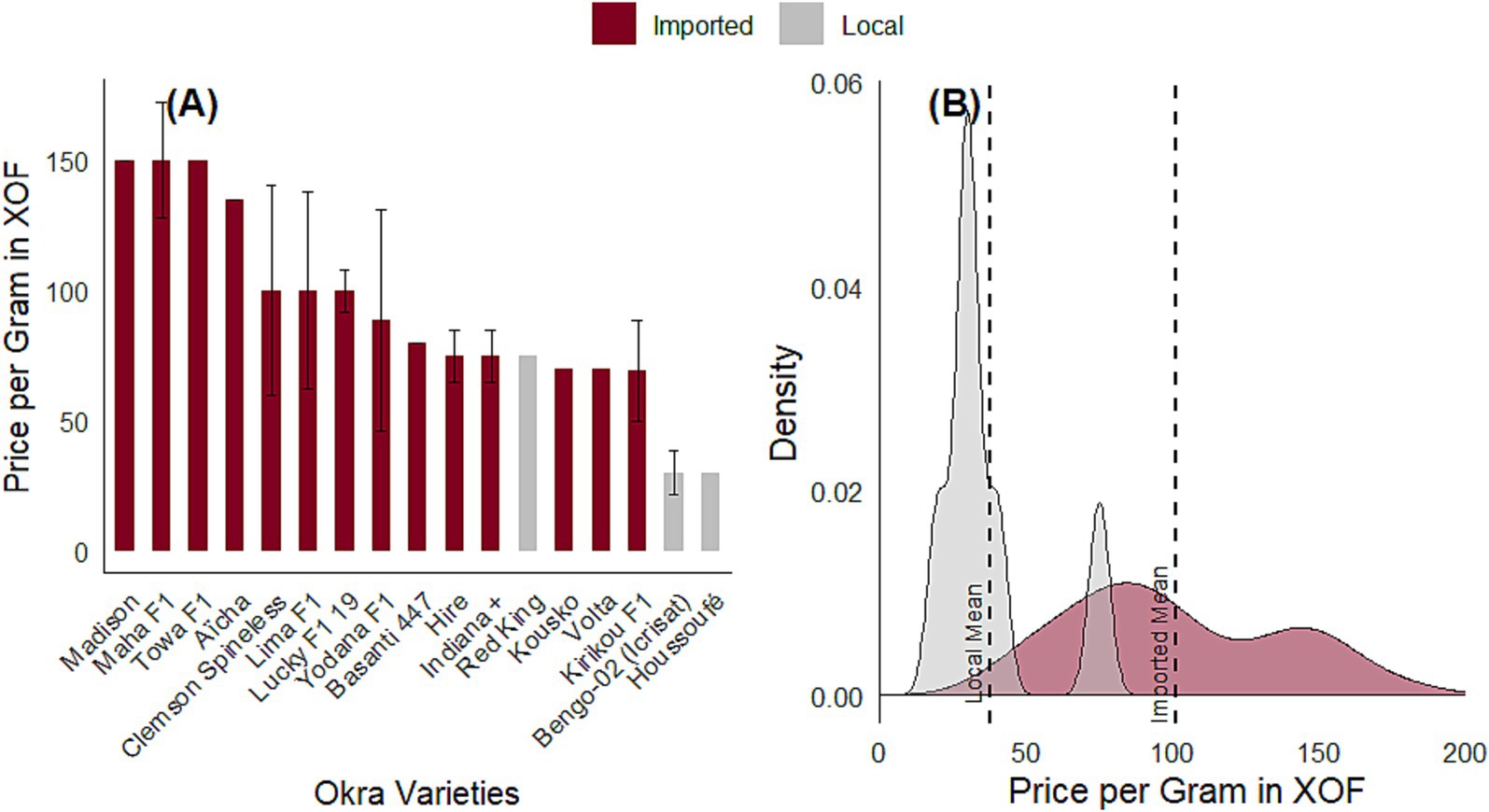
Figure 9. Okra seeds price variation by Source (Imported vs. Local). (A) Mean price per Gram per variety by Source. (B) Kernel density distribution of prices by Source.
Figure 9B provides additional insight into this pattern through kernel density distribution curves, which depict the price distribution for both imported and local okra. Local seeds exhibit a distinct, narrow peak centered around 35–40 XOF (≈0.06–0.07 USD), indicating low prices and consistent pricing. In contrast, imported seeds display a wider and more varied distribution, with a main peak located near 95 XOF (≈0.16 USD) and secondary peaks that imply tiered pricing within the imported category. Dashed vertical lines indicate the average price for each group, highlighting the difference between the two sources. Specifically, the average price of imported varieties is around 97.4 XOF (≈0.16 USD) per gram. This price differential could have an important implication for seed accessibility and adoption. The relatively high cost of imported seeds may pose a barrier for smallholder farmers.
4 Discussion
4.1 Okra seed systems in Benin
This study provides an in-depth analysis of the okra seed system in Benin, revealing key challenges related to seed availability, quality control, affordability and institutional support.
The regulatory framework governing the production, import, and distribution of okra seeds in Benin plays a pivotal role in ensuring seed quality, facilitating market access, and fostering the growth of the seed sector. The establishment of national and regional seed policies, along with regulatory bodies such as the National Plant Seeds Committee, suggests that there is a concerted effort to formalize and standardize seed production and trade practices and comply with requirements of the regionally harmonized seed regulations (ECOWAS, 2008). While the legal and institutional frameworks for seed systems have been reinforced, there is a need to strengthen collaboration between stakeholders in the okra seed sector to improve production and distribution, as proposed by Adigoun et al. (2022) for maize and Ayenan et al. (2017) for soybean seed systems in Benin. For instance, a strengthened collaboration between seed producers and the national agricultural research institute (INRAB) can help better plan the production of early generation seeds to meet the seed producers’ demand.
Our study, in alignment with other report on traditional vegetables seed systems in Africa highlighted the dominance of farmer seed systems, where farmers rely on self-saved seeds and informal market sources such as local markets, roadside vendors, or unregulated stalls where seeds are often sold without certification or verified origin, raising concerns about quality and traceability (Ayenan et al., 2021; Croft et al., 2018; Houegban et al., 2024; Kansiime et al., 2018; Nkongho et al., 2022; Pincus et al., 2018). The regulated seed system, characterized by certified seed production and quality packages, imported seeds from international seed companies, and regulated distribution channels, coexists alongside farmer seed systems, where farmers engage in seed saving and exchange practices (Louwaars and Manicad, 2022). Given that the farmer seed system provides the only source of seeds in areas beyond the reach of regulated distribution networks, it is crucial to recognize its role in seed diversity and resilience (Louwaars and Manicad, 2022). Recognizing the plurality of seed systems and understand how these systems work are critical to design tailor-made interventions to improve farmer’ access to high-quality seed. Capacity strengthening in seed production, marketing, and distribution and application of alternative quality assurance to state-led and centralized certification process will support the development of inclusive okra seed systems.
One striking finding is the low awareness among farmers about the specific varieties they cultivate. This knowledge gap illustrates a disconnect between farmers and the regulated seed supply chain, limiting their ability to make fully informed seed selection decisions. Farmers’ continued reliance on farmer seed sources self-saved or informally exchanged seeds reflects both tradition and practicality, especially in contexts where certified seeds are unavailable, unaffordable, or not well adapted to local conditions. This finding points to the need for a more integrated approach that supports and strengthens farmer seed systems improving quality, access to information, and recognition while also enhancing the accessibility and contextual relevance of regulated seed options (Ayenan et al., 2022). Farmers are rational in their seed choices, and the goal should be to ensure that both systems evolve to better meet their diverse and dynamic needs.
Seed availability and access remain critical concerns for smallholder farmers, particularly in remote areas. In the northern part of the country, where only six seed distributors were identified, long distances and sparse coverage limit the physical availability of certified seeds an issue consistent with seed security frameworks that define proximity and supply as key availability indicators (Remington et al., 2002; FAO, 2015; Ncube et al., 2023). In addition, access is constrained by high seed prices and limited purchasing power, which restrict adoption of improved varieties despite their potential agronomic benefits. While field-level data comparing yield differences between improved and local okra varieties are limited, farmers often lack concrete evidence to justify the price differential. As such, we recommend targeted on-farm demonstration trials, varietal performance monitoring, and yield documentation to inform farmer decision-making and close the information gap on the benefits of certified seed. Even when farmers seek certified seeds, availability is inconsistent during peak planting seasons due to slow variety approval and weak multiplication systems. To address formal sector supply gaps, private-sector involvement and decentralized seed hubs must be expanded. In addition, we propose the development of village-based agro-dealers and mobile seed kiosks as localized distribution models that can reduce travel burdens and bring seed closer to remote communities. These outlets could be integrated with extension services, enabling farmers to access both high-quality seeds and technical advice on variety selection and agronomic practices. In parallel, the farmer seed system which remains the primary source of okra seed requires targeted support to improve selection, storage, and seed quality assurance. Recognition of high-performing farmer managed varieties and investments in participatory seed quality monitoring could strengthen outcomes without requiring full formalization. Finally, while semi-formal systems may already exist in practice, structured models with technical oversight and basic quality protocols could help formalize these arrangements without excluding small producers. Interventions such as subsidies, localized breeding programs, and scalable certification models can support more equitable seed access while strengthening both formal and farmer-based systems.
4.2 Towards a more inclusive and efficient okra seed system
The constraints within the okra seed system reveal interconnected challenges related to seed pricing, availability, and farmer adoption. Distributors face difficulties accessing a diverse portfolio of high-quality varieties suited to different agro-ecological conditions and market demands, while farmers confront high seed prices, limited physical access to seed outlets, and persistent disease pressures. These factors contribute to a cycle in which low-cost, often lower-quality seeds dominate, particularly in underserved areas. Strengthening seed distribution networks can be achieved by supporting the establishment of decentralized agro-dealer outlets, particularly in remote zones, and promoting village-based seed enterprises that shorten supply chains and reduce transaction costs. Training and supporting local actors to become seed vendors, especially through public-private partnerships, can improve last-mile delivery. To reduce the cost of certified seeds, strategies may include subsidizing foundation seed for certified producers, offering targeted price support or voucher schemes for smallholder farmers, and promoting local multiplication of certified seed to reduce import dependence. Simplifying regulatory requirements for low-volume seed producers without compromising quality can also lower production costs. Ultimately, fostering better integration between regulated and farmer seed systems, supported by inclusive policy and investment frameworks, could enable more farmers to access improved varieties, resulting in higher adoption rates, enhanced yields, and increased economic returns throughout the okra value chain.
Findings from other vegetable seed systems in Africa suggest that integrating regulated and farmer seed systems can enhance both seed quality and accessibility. (Louwaars and De Boef, 2012; Etwire et al., 2013; Alemu, 2015; Etwire et al., 2016; Quarshie et al., 2021, Westengen et al., 2023). In Nigeria and Ghana, community-based seed production models have successfully bridged the gap between regulated breeding programs and smallholder farmers, and similar approaches could be adapted for Benin to strengthen the okra seed sector Public-private partnerships (PPPs) have also proven effective in expanding seed production and distribution for staple crops like maize and rice, highlighting the potential for similar collaborations in the okra sector to diversify seed sources and improve market access.
Several key interventions are recommended to enhance the efficiency and inclusivity of the okra seed system in Benin. Regulatory reforms should aim not only to simplify the certification process but also to reduce associated costs, which often deter small-scale seed producers from participating in the regulated sector. This could include flexible certification models and financial support mechanisms for local seed enterprises. Additionally, enforcement efforts should shift toward ensuring basic quality standards across all seed systems, including informal ones, rather than focusing solely on formal certification. This could involve introducing decentralized quality control mechanisms, training local seed inspectors, and developing participatory guarantee systems adapted to local realities. Exposing farmers to the performance of the newly released okra varieties through demonstration trials, seed fairs, and seed kits can improve varietal access and farmer choice. While raising farmer awareness about the benefits of quality seed is important, it should be complemented by tangible support to improve seed quality. This includes investments in training for seed producers, better seed processing tools, and community-led seed exchange platforms that promote the circulation of healthy, adapted varieties. Together, these efforts can enhance seed decision-making, expand access, and improve productivity across the okra seed system.
Recognizing the limitations of the current regulated seed system, this study also recommends establishing a semi-regulated certification model that streamlines certification processes, incorporates participatory quality assurance mechanisms (Ayenan et al., 2021), and provides technical support to small-scale seed producers (Louwaars et al., 2013). In parallel, addressing economic constraints through subsidized seed programs, microcredit schemes, and price transparency initiatives could improve the affordability and accessibility of quality seed for smallholder farmers across both regulated and farmer seed systems. While certified seed is generally understood to be more expensive than farmer seed, further research is needed to assess the comparative cost-effectiveness of both systems. An economic analysis that evaluates the yield gains, risk reduction, and return on investment from certified versus farmer seed could provide decision-relevant insights for different farmer profiles and agroecological zones. Additionally, future research should (1) investigate the genetic diversity of locally available okra varieties and support the participatory development of target product profiles to guide breeding priorities; (2) assess the feasibility of decentralized seed multiplication models to enhance supply chain resilience; (3) explore alternative certification pathways, including farmer-managed quality assurance systems adapted to local contexts; and (4) evaluate the current seed quality available in both regulated and farmer seed markets to inform targeted interventions.
The study relies on survey data, which could fail to capture trends, and could subsequently limit our understanding of the system evolution or seasonal shifts in seed practices. However, the inclusion of all key categories of actors along the okra seed chain and the experiences of the respondents ensures that the data collected reflect the functioning of the okra seed systems.
5 Conclusion
The okra seed system in Benin exhibits a dual structure: a regulated seed system defined by formal certification and official distribution channels, and a farmer seed system characterized by traditional seed-saving, informal exchange, and low regulatory oversight. This study finds that the farmer seed system remains the most widely used, with a significant proportion of growers relying on their own saved seeds or locally exchanged seed. Use of certified seed remains low, due to relatively high certification costs, limited access to foundation seed, and inadequate infrastructure among seed producers. Additionally, the distribution network is fragmented, with many seed distributors lacking formal authorization. To address these systemic challenges, we recommend an integrated approach that improves not replaces the existing seed systems. This includes fostering collaboration between regulated and farmer seed actors, simplifying certification requirements to reduce entry barriers for small-scale producers, and broadening the range of officially recognized okra varieties to reflect local adaptation needs. Rather than introducing a separate third seed system, we propose exploring flexible and inclusive certification models such as farmer-managed quality assurance or participatory guarantee systems that can bridge formal regulatory requirements and informal practices. Although not yet formalized in Benin, these models have been piloted in other contexts and may offer a pathway for enhancing seed quality without excluding traditional seed actors. To strengthen the dominant farmer seed system, we recommend supporting local seed quality assurance, building technical capacity for farmer seed producers, and formally recognizing well-performing farmer seed sources where appropriate. By leveraging the strengths of both systems and ensuring inclusive regulation, Benin can develop a more resilient and accessible okra seed system that improves productivity, supports smallholder farmers, and contributes to national food and economic security.
Data availability statement
The raw data supporting the conclusions of this article will be made available by the authors, without undue reservation.
Ethics statement
Ethical clearance was obtained from the World Vegetable Center Institutional Biosafety and Research Ethics Committee (IBREC ID: 2022-18). Prior to administering the questionnaire, the objective of the study was explained to the respondents, and their consent was obtained. Respondents voluntarily participated in the survey and had the liberty to decline to continue at any point during the interview.
Author contributions
JB: Formal analysis, Writing – review & editing, Visualization, Writing – original draft, Investigation, Data curation, Methodology, Conceptualization, Software. MA: Visualization, Writing – review & editing, Conceptualization, Supervision, Methodology. LA: Investigation, Writing – review & editing, Methodology, Conceptualization. SN: Methodology, Conceptualization, Writing – review & editing, Visualization. RS: Funding acquisition, Writing – review & editing, Resources, Validation, Visualization, Methodology, Supervision, Conceptualization, Project administration. EA-D: Validation, Writing – review & editing, Visualization, Methodology, Supervision, Conceptualization.
Funding
The author(s) declare that financial support was received for the research and/or publication of this article. This research was carried out with funding from the European Union and the Ministry of Foreign Affairs of the Netherlands through the project “Safe locally produced vegetables for West Africa’s consumers (SafeVeg)” – ID-4000003936, part of the DeSIRA program and implemented by the World Vegetable Center, CIRAD and Wageningen University & Research (WUR).
Acknowledgments
The authors are grateful for the contribution of farmers and other stakeholders involved in Okra seed systems in Benin, as well as the interviewers who help for data collection. We also acknowledge long-term strategic donors to the World Vegetable Center: Taiwan, United Kingdom, United States, Australia, Germany, Thailand, Philippines, South Korea, and Japan.
Conflict of interest
The authors declare that the research was conducted in the absence of any commercial or financial relationships that could be construed as a potential conflict of interest.
Generative AI statement
The authors declare that no Gen AI was used in the creation of this manuscript.
Any alternative text (alt text) provided alongside figures in this article has been generated by Frontiers with the support of artificial intelligence and reasonable efforts have been made to ensure accuracy, including review by the authors wherever possible. If you identify any issues, please contact us.
Publisher’s note
All claims expressed in this article are solely those of the authors and do not necessarily represent those of their affiliated organizations, or those of the publisher, the editors and the reviewers. Any product that may be evaluated in this article, or claim that may be made by its manufacturer, is not guaranteed or endorsed by the publisher.
Author disclaimer
The views expressed in this document can in no way be taken to reflect the official opinion of the European Union or the Ministry of Foreign Affairs of the Netherlands.
Supplementary material
The Supplementary material for this article can be found online at: https://www.frontiersin.org/articles/10.3389/fsufs.2025.1614338/full#supplementary-material
References
Achigan-Dako, E. G., N’Danikou, S., Assogba-Komlan, F., Ambrose-Oji, B., Ahanchede, A., and Pasquini, M. W. (2011). Diversity, geographical, and consumption patterns of traditional vegetables in sociolinguistic communities in Benin: implications for domestication and utilization. Econ. Bot. 65, 129–145. doi: 10.1007/s12231-011-9153-4
Achigan-Dako, E. G., Pasquini, M. W., Assogba Komlan, F., N’danikou, S., Yédomonhan, H., Dansi, A., et al. (2010). Traditional vegetables in Benin. Cotonou: Institut National des Recherches Agricoles du Bénin, Imprimeries du CENAP.
Adigoun, R. F., Houdegbe, A. C., Fassinou Hotegni, N. V., Segnon, A. C., N'Danikou, S., Adjé, C. A., et al. (2022). Enabling effective maize seed system in low-income countries of West Africa: insights from Benin. Front. Sustain. Food Syst. 6:1045629. doi: 10.3389/fsufs.2022.1045629
Alemu, K. (2015). Seed production and dissemination systems analyses: the case of Ethiopia. Food Science & Quality Management. 35, 25–37.
Almekinders, C. J., and Louwaars, N. P. (2002). The importance of the farmers’ seed systems in a functional national seed sector. J. New Seeds 4, 15–33. doi: 10.1300/J153v04n01_02
Ayenan, M. A. T., Aglinglo, L. A., Sognizoun, D., Tchokponhoue, D. A., Azagba, J., and Schreinemachers, P. S. R. (2022). Strategic actions for strengthening formal vegetable seed Systems in Benin. Position & Policy Papers; Staff Publications. Shanhua, Taiwan: World Vegetable Center, pp. 6. doi: 10.22001/wvc.75811
Ayenan, M. A., Aglinglo, L. A., Zohoungbogbo, H. P., N'Danikou, S., Honfoga, J., Dinssa, F. F., et al. (2021). Seed systems of traditional African vegetables in eastern Africa: a systematic review. Front. Sustain. Food Syst. 5:689909. doi: 10.3389/fsufs.2021.689909
Ayenan, M. A. T., Sèwadé, P. L., and Agboton, S. M. (2017). Towards effective soybean seed systems in Benin: current situation and prospects for production and delivery of good quality seed. J. Crop Improv. 31, 379–399. doi: 10.1080/15427528.2017.1304479
Croft, M. M., Marshall, M. I., Odendo, M., Ndinya, C., Ondego, N. N., Obura, P., et al. (2018). Formal and informal seed systems in Kenya: supporting indigenous vegetable seed quality. J. Dev. Stud. 54, 758–775. doi: 10.1080/00220388.2017.1308487
Dansi, A., Adjatin, A., Adoukonou-Sagbadja, H., Faladé, V., Yedomonhan, H., Odou, D., et al. (2008). Traditional leafy vegetables and their use in the Benin Republic. Genet. Resour. Crop. Evol. 55, 1239–1256. doi: 10.1007/s10722-008-9324-z
DSA. (2021). Production vegetable, Culture maraicheres. Available online at: https://apidsa.agriculture.gouv.bj/public/storage/uploads/csIv0MWqhdTQdfnpVrDksxxsuLpPCZwlQIMxu8DG.xlsx (Accessed October 28, 2024).
ECOWAS. (2008). Regulation C/REG.4/05/2008on harmonization of the rules governing quality control, certification and marketing of plant seeds and seedlings in ECOWAS region. Adopted by the 60th session of the ECOWAS Council of Ministers in Abuja: ECOWAS Official Journal, Vol. 53, 17–18.
Etwire, E., Ariyawardana, A., and Mortlock, M. Y. (2016). Seed delivery systems and farm characteristics influencing the improved seed uptake by smallholders in northern Ghana. Sustain. Agric. Res. 5:27. doi: 10.5539/sar.v5n2p27
Etwire, P. M., Atokple, I. D., Buah, S. S., Abdulai, A. L., Karikari, A. S., and Asungre, P. (2013). Analysis of the seed system in Ghana. Int. J. Adv. Agric. Res. 1, 7–13.
FAO (2015). Seed security assessment: a practitioner’s guide. Rome: Food and Agriculture Organization of the United Nations.
FAOSTAT. (2022). Available online at: https://www.fao.org/faostat (Accessed March 12, 2025).
Gemede, H. F., Ratta, N., Haki, G. D., Woldegiorgis, A. Z., and Beyene, F. (2015). Nutritional quality and health benefits of okra (Abelmoschus esculentus): a review. J. Food Process. Technol. 6:2.
Houegban, J., Aglinglo, L. A., N’Danikou, S., Tchokponhoué, D. A., Amissah, J. N., Ankamah-Yeboah, T., et al. (2024). Traditional African vegetables’ seed access and management practices: case of Vernonia amygdalina (Delile) in southern Benin. Front. Sustain. Food Syst. 8:1276736. doi: 10.3389/fsufs.2024.1276736
Kansiime, M., Bundi, M., Nicodemus, J., Ochieng, J., Marandu, D., Njau, S., et al. (2021). Assessing sustainability factors of farmer seed production: a case of the good seed initiative project in Tanzania. Agric. Food Secur. 10:15. doi: 10.1186/s40066-021-00289-7
Kansiime, M. K., Karanja, D. K., Alokit, C., and Ochieng, J. (2018). Derived demand for African indigenous vegetable seed: implications for farmer-seed entrepreneurship development. Int. Food Agribus. Manag. Rev. 21, 723–739.
Karl, K., Rosenzweig, C., MacCarthy, D., Porciello, J., Neufeld, L., Holmes, B., et al. (2024). Opportunity crop indicators: assessing the climate adaptation potential of opportunity crops in Africa. PREPRINT (Version 1) available at Research Square. doi: 10.21203/rs.3.rs-5349945/v1 (Accessed December 4, 2024).
Kuo, G., N’Danikou, S., Dinssa, F., Roothaert, R., Rugalema, R., Simon, J., et al. (2022). All-Africa summit on diversifying food systems with African traditional vegetables to increase health, nutrition, and wealth. J. Med. Active Plants 11:1.
Liu, Y., Qi, J., Luo, J., Qin, W., Luo, Q., Zhang, Q., et al. (2021). Okra in food field: nutritional value, health benefits and effects of processing methods on quality. Food Rev. Int. 37, 67–90. doi: 10.1080/87559129.2019.1695833
Louwaars, N. (1995) Policies and strategies for seed system development. Proceedings of the integrating seed systems for annual food crops, a workshop held in Malang, Indonesia
Louwaars, N. P., and De Boef, W. S. (2012). Integrated seed sector development in Africa: a conceptual framework for creating coherence between practices, programs, and policies. J. Crop Improv. 26, 39–59. doi: 10.1080/15427528.2011.611277
Louwaars, N. P., de Boef, W. S., and Edeme, J. (2013). Integrated seed sector development in Africa: a basis for seed policy and law. J. Crop Improv. 27, 186–214. doi: 10.1080/15427528.2012.751472
Louwaars, N. P., and Manicad, G. (2022). Seed systems resilience—an overview. Seeds 1, 340–356. doi: 10.3390/seeds1040028
McGuire, S., and Sperling, L. (2016). Seed systems smallholder farmers use. Food Secur. 8, 179–195. doi: 10.1007/s12571-015-0528-8
Ncube, B. L., Wynberg, R., and McGuire, S. (2023). Comparing the contribution of formal and local seed systems to household seed security in eastern Zimbabwe. Front. Sustain. Food Syst. 7:1243722. doi: 10.3389/fsufs.2023.1243722
Nkongho, R. N., Efouba-Mbong, J. T., Ndam, L. M., Ketchem, G. A., Etchu-Takang, E. G., and Agbor, D. T. (2022). Seed production system and adaptability of okra (Abelmoschus esculentus L.) cultivars in Buea, Cameroon. PLoS One 17:e0278771. doi: 10.1371/journal.pone.0278771
Pincus, L., Croft, M., Roothaert, R., and Dubois, T. (2018). African indigenous vegetable seed systems in western Kenya. Econ. Bot. 72, 380–395. doi: 10.1007/s12231-018-9440-4
Quarshie, P. T., Abdulai, A. R., and Fraser, E. D. (2021). Africa's “seed” revolution and value chain constraints to early generation seeds commercialization and adoption in Ghana. Front. Sustain. Food Syst. 5:665297. doi: 10.3389/fsufs.2021.665297
R Core Team, R (2020). R Core team R: a language and environment for statistical computing. Vienna, Austria: R Foundation for Statistical Computing. 116.
Remington, T., Maroko, J., Walsh, S., Omanga, P., and Charles, E. (2002). Getting off the seeds–and–tools treadmill with CRS seed vouchers and fairs. Disasters, 26, 316–328. doi: 10.1111/1467-7717.00209
Sperling, L., and Cooper, H. D. (2003). Understanding seed systems and strengthening seed security. In Improving the effectiveness and sustainability of seed relief Proceedings of a stakeholders’ workshop, Rome: Food and Agriculture Organization.
Tidjani, C. T. M., Chougourou, D., and Akpo, A. (2020). Amélioration du système semencier des maraîchers dans la Ville de Cotonou au sud du Bénin. Master’s thesis, Abomey-Calavi, Bénin: École Polytechnique d’Abomey-Calavi, ii–59.
Westengen, O. T., Dalle, S. P., and Mulesa, T. H. (2023). Navigating toward resilient and inclusive seed systems. Proc. Natl. Acad. Sci. USA 120:e2218777120. doi: 10.1073/pnas.2218777120
Keywords: seed system, certified seeds, farmer seeds system, regulated seed system, seed accessibility, seed sources, okra
Citation: Blalogoe JS, Ayenan MAT, Aglinglo LA, N’Danikou S, Schafleitner R and Achigan-Dako EG (2025) Challenges and opportunities in the okra (Abelmoschus spp.) seed system in Benin. Front. Sustain. Food Syst. 9:1614338. doi: 10.3389/fsufs.2025.1614338
Edited by:
Prafull Salvi, National Agri-Food Biotechnology Institute, IndiaReviewed by:
Edmore Gasura, University of Zimbabwe, ZimbabweBulisani Lloyd Ncube, University of Cape Town, South Africa
Copyright © 2025 Blalogoe, Ayenan, Aglinglo, N’Danikou, Schafleitner and Achigan-Dako. This is an open-access article distributed under the terms of the Creative Commons Attribution License (CC BY). The use, distribution or reproduction in other forums is permitted, provided the original author(s) and the copyright owner(s) are credited and that the original publication in this journal is cited, in accordance with accepted academic practice. No use, distribution or reproduction is permitted which does not comply with these terms.
*Correspondence: Jelila S. Blalogoe, amVsaWxhLmJsYWxvZ29lQHdvcmxkdmVnLm9yZw==; Mathieu A. T. Ayenan, bWF0aGlldS5heWVuYW5Ad29ybGR2ZWcub3Jn; Enoch G. Achigan-Dako, ZS5hZGFrb0BnYmlvcy11YWMub3Jn
 Jelila S. Blalogoe
Jelila S. Blalogoe Mathieu A. T. Ayenan
Mathieu A. T. Ayenan Lys Amavi Aglinglo
Lys Amavi Aglinglo Sognigbe N’Danikou
Sognigbe N’Danikou Roland Schafleitner
Roland Schafleitner Enoch G. Achigan-Dako
Enoch G. Achigan-Dako